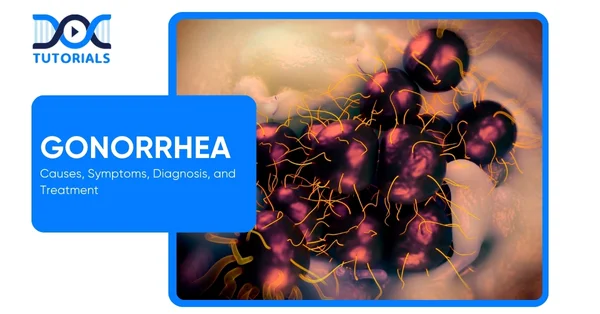Gonorrhea: Causes, Symptoms, Diagnosis, and Treatment

Gonorrhea is one of the common sexually transmitted infections (STIs) which attack the mucous membranes of the urethra, cervix, rectum, throat and eyes. Infection is disproportionately common in sexually active young adults, but is usually asymptomatic, which makes screening crucial.
This condition can be prevented and cured with antibiotics at an early stage. However, the increasing prevalence of antibiotic resistance cases has made it a significant public health concern. Gonorrhoea is a high-yield topic among medical students, with the WHO (World Health Organisation) estimating over 80 million new global cases in 2020.
Therefore, understanding its causes, symptoms, diagnosis, and treatment is a step forward in the NEET PG exam. Continue reading to learn more about Gonorrhoea.
What is Gonorrhea?
Gonorrhea is an STI that is transmitted by Neisseria gonorrhoeae, which can only infect humans. It is most often transmitted by unprotected vaginal, oral or anal intercourse with an infected partner. The bacteria adhere to mucosal cells, which leads to inflammation and discharge in the infected areas.
Normally, gonorrhea presents as urethritis in males and cervicitis in females. Young adults, most commonly between the ages of 15 and 24, are affected and can be treated with the correct antibiotics. Since symptoms are not apparent in most cases, regular HIV (human immunodeficiency virus) testing is imperative among individuals with multiple sexual partners.
What are the Causes of Gonorrhea?
The bacteria N. gonorrhoeae are a noncapsulated, gram-negative, kidney-shaped diplococcus. These bacteria cause infection when they are transmitted during intimate contact from an infected person to another.
The key gonorrhea causes are unprotected sexual activities, including vaginal, anal, or oral sex without a condom with a partner who has gonorrhea. Pili are the principal virulence factors of gonococci that facilitate adhesion to host cells and prevent bacteria from being phagocytosed.
What are the Risk Factors for Gonorrhea?
The Important risk factors of gonorrhea include:
- Multiple sex partners
- A new sexual partner
- A partner with another STI.
Teenagers and young adults have the highest incidence. Men who have sex with men and sex workers are also at higher risk due to network factors.
Furthermore, a pregnant woman infected with gonorrhea may pass the infection to the unborn baby at the time of delivery, which may lead to an eye infection in a newborn (ophthalmia neonatorum). Notably, gonorrhea is not spread by casual contact like hugging, sharing toilets, or kissing without intercourse. It strictly requires sexual or perinatal exposure.
What are the Symptoms of Gonorrhea?
Gonorrhea is a venereal disease reported since ancient times; it produces various infections in males, females and also in newborns.
- In Males
Acute urethritis is the most common manifestation:
- It is characterised by purulent urethral discharge
- The incubation period is 2 to 7 days
- Untreated cases may develop complications, such as epididymitis, prostatitis, and balanitis.
- Infection may spread to periurethral tissues, causing an abscess with sinus formation.
- In Females
Gonococcal infection is less severe in females, with more asymptomatic carriage than in males:
- Mucopurulent Cervicitis: It is the most common presentation, characterised by scanty vaginal discharge
- Vulvovaginitis: It is not seen in adult females as the adult vagina is resistant to gonococcal infection. However, gonococcal vaginitis can develop in prepubertal girls and postmenopausal women, where the vagina is lined by thin mucosa with a higher pH.
- Infection Spread: Infection may spread to the Bartholin’s gland, endometrium and fallopian tube. Salpingitis and pelvic inflammatory disease can lead to infertility and sterility.
- Fitz–Hugh–Curtis Syndrome: It is a rare complication characterised by peritonitis and associated perihepatic inflammation.
- In Both Sexes
The following manifestations may occur in both sexes:
- Anorectal Gonorrhea: Rectal isolates are usually multidrug-resistant
- Pharyngeal gonorrhea is spread by orogenital sex
- Ocular gonorrhea
- In Pregnant Women
Gonococcal infection causes prolonged rupture of the membranes, premature delivery, chorioamnionitis, and sepsis in the infant.
- In Neonates (Ophthalmia neonatorum)
It is characterised by purulent eye discharge and typically occurs within 2–5 days of birth. Transmission occurs during birth from colonised maternal genital flora.
- Disseminated Gonococcal Infection (DGI)
It develops rarely following gonococcal bacteremia, characterised by polyarthritis, and is occasionally accompanied by dermatitis and endocarditis.
- In HIV-infected People
Nonulcerative gonorrhea enhances the transmission of HIV by three to five-fold, possibly because of increased viral shedding.
What is the Diagnosis of Gonorrhea?
The diagnosis of Gonorrhea includes:
- Specimen Collection
Urethral swabs in men and cervical swabs in women are the preferred specimens for collection.
- In males, the urethral meatus is cleaned with gauze soaked in saline. The purulent discharge is expressed by pressing at the base of the penis and collected directly onto slides or swabs.
- Dacron or rayon swabs are preferred, as cotton and alginate swabs are inhibitory to gonococci.
- In chronic urethritis, where discharge is minimal, prostatic massage is performed to collect the secretion; alternatively, the morning drop of secretion can be collected.
- Transport Media
Specimens should be transported immediately. If not possible, then it should be collected on charcoal-coated swabs kept in Stuart’s transport medium; alternatively, Amies medium can be used. Currently, various commercial transport devices, such as the Gono-Pak system, are being used.
- Microscopy
Gram staining of urethral exudates reveals gram-negative intracellular kidney-shaped diplococci. It is highly specific and sensitive in symptomatic men. However, in females, it is only 50% sensitive because the presence of commensal Neisseria species may confound the interpretation. Hence, culture is recommended for the diagnosis of gonorrhea in women.
- Culture
Endocervical culture has a sensitivity of 80–90%. As cervical swabs contain normal flora, selective media are preferred, such as Thayer Martin medium. Blood culture (using automated blood culture systems) and synovial fluid cultures should be done in suspected cases of DGI.
- Identification
Species identification is crucial for differentiating gonococci from other commensal Neisseria species.
- Gonococci are catalase and oxidase-positive
- They ferment only glucose, but not maltose and sucrose
- Automated systems such as MALDI-TOF (Matrix-Assisted Laser Desorption/Ionisation Time-of-Flight) can be used.
What are the Treatment Options for Gonorrhea?
The good news is that gonorrhea is curable with antibiotics if treated properly. However, Neisseria gonorrhoeae has developed resistance to many drugs, making gonorrhea treatment challenging. The Treatments are listed below:
- First-line treatment: Ceftriaxone 500 mg administered intramuscularly once.
- Alternative: If ceftriaxone is contraindicated, cefixime 800 mg is given orally.
- Coexisting Chlamydia: Add doxycycline 100 mg orally twice daily for 7 days if chlamydia is not excluded.
- Allergy (cephalosporin): Intramuscular Gentamicin along with oral Azithromycin.
- Treat Partners: Test or treat all recent partners and practice abstinence until 7 days post-treatment.
Note: Gonococci were initially sensitive to most antibiotics, including sulfonamides, penicillins, and quinolones; however, due to their constant use over the years, resistance has developed, e.g. penicillinase-producing strains of N. gonorrhoeae.
FAQs about Gonorrhea
1. How is gonorrhea transmitted?
Gonorrhea is spread through unprotected vaginal, anal or oral sex with an infected individual. It is not transmitted through normal contact, and condoms can reduce the risk.
2. What is the role of nucleic acid amplification tests (NAATs) in gonorrhea diagnosis?
NAATs are the best as they have high sensitivity and specificity rates, particularly in extragenital locations.
3. What are the main complications if gonorrhea is untreated?
Untreated gonorrhea can lead to serious problems. It may result in pelvic inflammatory disease (PID), infertility, and ectopic pregnancy in women. In men, it may result in epididymitis and, infrequently, infertility. It may also enhance HIV risk and infrequently generate a disseminated form of infection (joint/skin issues).
4. Can gonorrhea influence pregnancy outcomes?
Yes, it is associated with preterm labour, low birth weight, and newborn conjunctivitis if untreated.
5. Is there a vaccine for gonorrhea?
Currently, there is still no authorised vaccine for gonorrhea, but studies are underway against virulence determinants.
Conclusion
Gonorrhea is a highly prevalent, curable sexually transmitted infection with subtle signs. N. gonorrhoeae can spread via unprotected sex, with little to no signs. Early detection with NAATs is crucial, with the gonorrhea treatment being a single dose of intramuscular ceftriaxone.
Untreated gonorrhea may cause PID, infertility, and a higher risk of HIV. Therefore, it should receive more attention through prevention and early treatment. Keep updated with DocTutorial by mastering these facts and ace your exams and future patient care.
Join DocTutorials today and explore our NEET PG course to excel in your medical career.
Latest Blogs
-

NEET SS Exam 2024: Analysis, Key Dates, Counselling
The NEET SS 2024 exam kicked off on March 29, 2025. Over two days and two slots, candidates across 13…
-

NEET PG Registration 2025: An Essential Guide For Exam Prep
The NEET PG registration, which is conducted online, is a crucial step in the exam process. Filling out the NEET…
-

NEET PG Syllabus 2026: A Must-Have Complete Guide for Exam Success
The NEET PG Syllabus acts as one of the foundation stones for aspiring postgraduate medical students like you who are…




